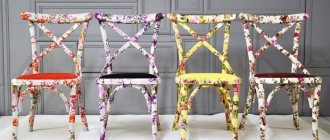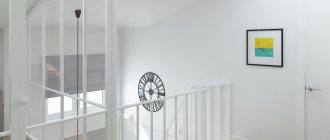3881
In the last decade, classic carpets with geometric patterns are leaving city apartments; they are becoming an attribute of solid country life. The modern consumer gives preference to new materials that allow us to get rid of the banal idea of the standard of prosperity and comfort.
In addition to the annoying uniformity, apartment owners consider the ability of carpets to accumulate dust to be a big disadvantage. It causes allergies and worsens the course of pulmonary diseases. These products have to be taken outside and cleaned frequently. This procedure is not easy and takes time.
Tiles in the kitchen
To avoid using textiles, you should lay tiles on the floor in the kitchen. It can be laid out in the form of a carpet, which will give an interesting look, and can easily complement a classic style without overloading with details. If you make heating under the ceramics, then the kitchen will have maximum comfort and it will be a pleasure to be in such a room. But it is important to think about heating even during repairs.
Hand-main rug
Floor coverings made with your own hands look no less expensive than store-bought ones. They contain love, the warmth of home, and history, which is why the rugs look special in the room. To do this, you will need unnecessary things that are cut into shreds and sewn together, creating a certain pattern. This style has Scandinavian roots and is called patchwork.
A rug can be woven from threads, or threads can be made from old T-shirts. The most fashionable is a rug knitted with very thick woolen threads. This knitting turns out to be very large. It takes a lot of time to do handicrafts, but it's worth it.
what can you put on the floor instead of carpet?
Running with an “egg”. We put a ping pong ball on a teaspoon and run around the entire apartment, trying to keep the ball on the spoon. From 3 years. Chatterboxes. Let's talk quickly. Who can do it longer? From 3 years. We think quickly. One player quickly names a word. The other person should immediately say what came to his mind in this regard. Then we change roles. From 4 years. Veterinary hospital. We put soft toys in bed and treat them: bandage them, give medications, measure the temperature, apply compresses, etc. From 3 years. Let's put on makeup. Painting your face in front of the bathroom mirror. From 4 years. We give names. We come up with some funny name for each finger. From 2 years. Let's keep our balance. With arms extended to the sides, we walk like a tightrope walker along the very edge of the carpet. From 3 years. We score goals. We use a string to mark the gate on the carpet. From some distance away, we throw ping-pong balls at the goal. Each hit earns a point. From 3 years. We make wishes about people. We look out the window. We come up with various stories about the people we see below. From 4 years. Witch game. We lay out a circle from the rope. This is a witch's house, in which one of the players - a witch - lies in wait for prey. The rest are crawling around the witch's house. When the witch comes out, everyone runs away very quickly. From 2 years. Ghost game. Everyone wraps themselves in white scarves and circles around the apartment like ghosts, making terrifying sounds. From 4 years. Dog game. One player is chosen as a dog. Others lead him on a leash throughout the apartment. From 2 years. Game of steps. We climb the stairs step by step. We come up with a name for each new step. From 5 years. Magnet game. Place a magnet under the paper and a coin on the paper. Use a magnet to move the coin along the paper. From 4 years. Forfeit. We collect forfeits from the players. We ask others: “What should the player who owns this forfeit do?” From 3 years. Let's play traffic. Using a thick brush and paints, we draw streets on a large sheet of paper. When the paints are dry, we begin driving the toy car around the roads. From 2 years. Let's play ice cream parlor. Fill a yogurt cup with fruit juice, yogurt, etc. and freeze it. Decorate the ice cream and serve. From 3 years. We play hide and seek. One is hiding in the apartment, and the others must find him. From 2 years. Let's play robbers. We hide several objects in the room. Players returning to the room must find the missing item. From 4 years. Toy money. We put the coins under the paper. Using a soft pencil, rub over the coin. We cut out paper money. From 5 years. We depict a snake. The more players, the better. We run around the apartment one after another. The guide tells the players what they should do, such as crawl around the table or tumble around the room. From 3 years. We are looking for pictures. The participant in the game looks for a picture in an illustrated book. Others must guess it. From 2 years. We are looking for a ring. We quietly transfer the ring to the fist of another player. You need to guess in which hand the ring is hidden. From 4 years. Blot pictures. Spray ink onto paper. Fold the paper with the blot inward, then unfold it again. Draw a picture from the prints. From 3 years. Swing. One lies down on the blanket, the others lift it higher and swing it. From 5 years. Skittles. We place the cubes on the carpet like skittles and knock them down with a tennis ball. From 2 years. We glue the collage. We tear newspaper or magazine pages into pieces. From this we glue a colored collage. From 3 years. A room out of a box. We make a room out of a cardboard shoe box. We draw furniture on paper, cut it out and paste it into the box. From 5 years. Beds made from matchboxes. We make cribs from matchboxes, and cut out suitable size pillows and blankets from paper. We draw little people on paper, cut them out and put them in cribs. From 5 years. Who will blow next? We blow on the bottle caps so that they fly off as far as possible. From 3 years. Domino ribbon. We arrange the dominoes one after another into a long ribbon, placing them on a short edge. When the ribbon is ready, push the first domino. All the dominoes fall, overturning one after another. From 2 years. We make paper animals. We draw any animals on thick paper. Cut it out. Glue a strip of cardboard as a stand. From 5 years. Making a picture book. Cut out pictures from a catalog or magazine. Glue it into a notebook and decorate the cover. From 4 years. We make boats. We make boats from walnut shells: we glue triangular sails from paper. We let the boats float in a basin or in a bathtub. We blow on them in different directions. From 2 years. Mother and child (father and child). With a reversal of roles: adults play children and vice versa. From 2 years. Mosaic. Cut a rectangle out of paper. Then cut it into 10 pieces of different shapes. Mix the pieces. Make a rectangle out of the pieces again. From 5 years. Stringing hearts. Cut out hearts from colored paper. We make a hole in each heart and string it on a cord. We hang the chain. From 5 years. Let's hum. One of the players begins to hum a melody. Others should recognize her. From 3 years. We dress up the dolls. We make outfits for dolls from scraps. From 4 years. Outline the hand. We place our hand on the paper. Draw along the outline with a pencil. Cut out and paint with colorful patterns. From 5 years. Omelette. Cut out a circle the size of a plate from yellow colored paper and fold it in half. This is an omelette. We fill it with various little things (for example, old photographs, unexpected pictures, fragrant flower petals, raisins or coins for good luck). We serve the omelet on a plate and offer it to the assembled family members as a snack before the meal. From 3 years. We empty our wallet. We pour all the coins from the wallet onto the table and sort them. From 3 years. Ping pong in the room. We sit on the floor. Using cardboard, hit the ping pong ball against the wall. From 3 years. Throwing up a balloon. Throw a well-inflated balloon into the air. You need to push it up with your index finger, preventing it from falling. From 4 years. We crawl on our backs. We lie on our backs and move around the room, trying not to touch anything. From 4 years. Designing hairstyles. We bring bows, barrettes and hair hoops. We give each other unusual, fantastic hairstyles. From 4 years. Prince and Princess. We glue crowns out of gold paper and put them on. From 3 years. Scratched pictures. We paint the surface of the paper with colored wax pencils, and on top with black paint. Using some object, we scratch various squiggles and lines so that the colored base appears through the black background. From 4 years. We hide the candy. All but one player leaves the room. The remaining one hides ten candies there, then calls the others again. The one who finds the most candies wins. From 2 years. Birds fly high. Players drum their fingers on the edge of the table. Everyone takes turns naming an animal. If it flies, everyone raises their hands; if it doesn’t fly, they continue to drum. If someone makes a mistake, he gives away his forfeit. From 3 years. “Inflating” the pictures. Spray different paints on the paper, adding more water. Blowing through a straw produces multi-colored spots. From 3 years. We tell stories. One begins to tell a story. In the middle he is interrupted, and the next one must continue the story. From 4 years. We look at the photographs. We come up with and tell stories to accompany the photographs. From 2 years. Drawing musical pictures. Let's turn on the music. On a piece of paper we draw colorful shapes that are associated with music. From 4 years. We draw on fabric. We use textile paints to paint fabric, such as an old T-shirt or bed sheet. From 3 years. Let's draw little people. We wet our finger. Then we dip it in ink and press it to the paper. We draw a little man from the print: we finish drawing the face, arms and legs. From 5 years. Continued drawings. Place a red dot in the center of the sheet of paper. We invite the next person to continue the drawing. From 4 years. We destroy the tower. We build a tower from boxes or cubes. From some distance we try to destroy it with a ping pong ball. From 2 years. Horse racing. We ride on a tightly inflated balloon until it bursts. From 2 years. Folding pictures. We draw the head on paper, bend it back and pass it on to someone else, who draws the stomach and arms and passes it on again, he finishes drawing the legs and feet. Expand and look at the drawing. From 4 years. Blind chicken. With our eyes closed, we try to walk from one room to another without hitting anything. From 3 years. Laughing is prohibited. We are trying to make our friend laugh by telling him all sorts of nonsense. His job is to stay serious. Who will last longer? From 3 years. We are building a house. Cover the table with a large tablecloth or blanket. We climb under the table. The main thing is not to forget provisions. From 2 years. Speedwalking competition. Everyone puts on very large shoes and runs a race through the entire apartment. From 2 years. Sort the cubes. We sort all the cubes by color and shape. From 2 years. We put up gates from bottle caps. We install a corridor of several gates. To do this, we put two caps together. We push the coins through the gate with our finger. From 5 years. We count cars. We look out the window. We make a bet on how many cars (or how many cars of a certain color or model) will pass by the house over a period of time. From 5 years. We count the points. For those who are learning to count. We throw the dice one by one. The one who scores more points wins. From 4 years. Dancing. We turn on the music, then we dance like crazy. From 2 years. Guessing the animals. Each one depicts an animal. Others must guess which one. From 5 years. Let's guess the sounds. One player closes their eyes and tries to guess which of the other players just snored, grumbled or meowed. From 4 years. Learning to jump. Jump on one leg for as long as possible. From 4 years. Figure-rug. Using trousers, a shirt and boots, we lay out a figure on the floor. Draw a face of suitable size on paper, cut it out and apply it. From 4 years. Football sitting. Two players sit opposite each other and play with a ping pong ball with their feet. From 2 years. Finger caps. From the circles we glue each finger into its own pointed hat. From 4 years. We flip the coin. Two players place a coin on the table and use their finger to shoot the coin from one to the other. From 4 years. Something you can't see. We wish for some colored thing in the room. We name the color and ask you to guess this item. From 4 years. For example, in the blink of an eye, with the help of a tablecloth and towels, turn the table into a cave, where you can so comfortably hide from everyone. Or turn the nursery into a treasure island, and the children into treasure hunters, for which parents need to hide some new toys (dolls, cars, balloons, etc.) in different places. Of course, there will be quite a bit of chaos. But the child will be happy, and you will save your nerves. And to clean up - well, right after the games you can clean up. Both two-year-olds and first-graders are very fond of various boxes, boxes and drawers filled with all sorts of things, in which it is a pleasure to rummage through them. Chance, imagination, preferences and the age of the child will help turn this simple activity into something exciting (just do not leave children under three years old unattended so that they do not accidentally swallow some small object). Sorting trinkets. We take buttons, nuts, and spools of thread out of the box and sort them. The same applies to chestnuts, sea pebbles and shells brought from vacation or brought from your last walk. We advise you to stock up on empty boxes and jars in advance (from the age of two). We count money. We shake out the change from our wallet and learn to count it. You can examine the contents of your mother’s bag (after removing everything remotely dangerous from it: headache pills, etc.) (from two and a half years old). We put the photos and pictures in order. We carefully examine family photographs and pictures taken on vacation and arrange them in order (for children, give them second copies, which you don’t mind spoiling). The same can be done with images of animals, toys and children from catalogs and illustrated magazines. It gives children great pleasure to help their mother with her household chores. This, of course, slows down the work, but the child is busy. Loading the washing machine. Let the baby hand his mother the laundry prepared for washing or even load it into the machine himself - even a one and a half year old baby can handle this. Let's clean up. Use a damp cloth or sponge to wipe down unpolished doors, cabinet doors or floors. You can also start wiping toy cars, doll houses, and boats (from three years old). Younger children can brush off the dust with a soft brush. We bake pies. Let's knead the dough a little more than required. Place a small portion in a special plastic bowl. Let's give the child some cocoa, grated nuts, coconut flakes and give him a spoon. We bake children's pies separately on a small baking sheet (from three years old). If you provide your baby with paints, glue, paper and children's scissors (with round ends), he will have great fun, even if he is not yet three years old (scissors can be given from the age of three). Cover the table with newspaper to prevent it from getting dirty, and put on the child an adult shirt or T-shirt as a work robe. Use water-soluble glue that does not contain chemical solvents (it will not produce toxic fumes and is easy to wash off). Let's draw money. Place the coin under a piece of paper and shade it with a pencil until the image of the coin appears. Carefully cut out the image (from three years old). We make signets. Corks and potato quarters are suitable for making signets. Pour in a lot of paint (for finger painting), wet the signet and then press it onto the paper or the surface of the box. Parents can cut out a signet design with a knife on a potato or cork (from two and a half years old). Let's make a collage. We cut out pictures from old catalogs and magazines and paste them onto paper or cardboard (from two and a half years old). Older kids can cut out pictures on their own (from the age of three). We create landscapes. You can, for example, take cotton wool, pieces of white tracing paper, adhesive tape for glitter, polystyrene foam, small twigs and pebbles as trees and rocks and create a winter landscape. Use hard cardboard for the backing. You can also depict a country of dinosaurs, a dense forest, a summer lawn (from three and a half years old). We make stained glass windows. Together with your child, paint the window glass in the nursery with easily washable paints (from three and a half years old). We make figures from salt dough. Take two parts flour and water and one part salt. Mix flour with salt, add water and knead the dough (with your help). The dough dries out quickly, so it needs to be kneaded in small portions. Now you can sculpt, for example, products for a store or a toy kitchen, or other figures. We place the figures in the oven and dry them for three hours at a temperature of 100 degrees, and then paint them with poster paints (from three years old). We write letters. A letter to grandparents, best friend or friend is simply drawn and sealed (from the age of four). We are building a city. This is a sequel game. Take an old plain tablecloth or sheet, lay it on the floor, attach the corners to the floor with duct tape or weigh them down with some weight. Use a thick felt-tip pen to mark the main lines. Let the child finish the rest; later he will be able to place figures and cars on this canvas and play with them (from the age of four). We embroider on cardboard. You can buy cardboard cards ready-made, but you can also make them yourself. On pieces of cardboard, first apply a hole pattern with an awl. Then give the cards to the child: let him use a thick darning needle with a variegated woolen thread or cord to “embroider” the pattern marked with holes (from the age of three).
Linoleum
The material is much cheaper than tiles and has a variety of colors and textures. Linoleum is perfect for any interior. It has thermal insulation and noise insulation properties, is easy to clean and is characterized by high wear resistance. There are linoleum based on jug or felt, which gives it softness. This coating requires careful care. It is best used for bedrooms or children's rooms.
Kavrolin
Those who do not like to wear slippers at home should put carpet on the floor. It is soft and retains warmth. It is easy to care for, just use a vacuum cleaner with clean water, and the coating will last for many years. The advantage of carpet is that it traps dust and debris and prevents it from spreading to other rooms. But it can cause allergies.
Good DIY
You can make gorgeous lint-free floor mats yourself. This will require certain skills, but it will allow you to have an original item in your kitchen interior.
Quilted fabric
There are many options for making such things. Usually you need: multi-colored stripes (scraps) of different fabrics, in some cases durable fabric for the base, having a sewing machine at home, sometimes you can do without it. This rug can be made using the patchwork technique. But perhaps the easiest way to make such a rug is:
- cut strips from shreds;
- sew short strips into long ribbons;
- weave braids from these ribbons;
- sew (connect) these strips.
Depending on how the strips are sewn, you can get rugs of different shapes (rectangular, round).
DIY patchwork rugs, watch the video on how to make:
Knitted round
For such rugs, you can also use scraps and scraps of different fabrics, synthetic (nylon) and cotton yarn. You can crochet chair covers and potholders to match the rugs.
One of the most common techniques for knitting such products is oversized crochet. These rugs are usually knitted with a single crochet stitch. Find out about interesting kitchen design ideas here.
A striped rug will liven up a plain floor
When making a rug with your own hands, you should take into account that not only should it be beautiful and match the style of the kitchen, but it will also need to be washed or cleaned often.











